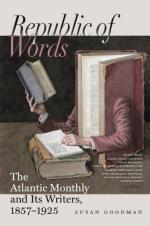Here are brought together the sentiments of certain vegetable productions of Greece, but sentiments so entirely subordinated to the flexure of the abstract line, that their natural significance is almost lost in a new and more human meaning. Here is the Honeysuckle, the wildest, the most elastic and undulating of plants, under the severe discipline of order and artistic symmetry, assuming a strict and chaste propriety, a formal elegance, which render it at once monumental and dignified. The harmonious succession and repetition of parts, the graceful contrasts of curves and the strict poise and balance of them, their unity in variety, their entire subjection to aesthetic laws, their serious and emphatic earnestness of purpose,—these qualities combine in the creation of one of the purest works of Art ever conceived by the human mind. It is called the Ionic Anthemion, and suggests in its composition all the creative powers of Greece. Its value is not alone in the sensuous gratification of the eye, as with the Arabesque tangles of the Alhambra, but it is more especially in its complete intellectual expression, the evidence there is in it of thoughtfulness and judgment and deliberate care. The inventor studied not alone the plant, but his own spiritual relationships with it; and ere he made his interpretation, he considered how, in mythological traditions, each flower once bore a human shape, and how Daphne and Syrinx, Narcissus and Philemon, and those other idyllic beings, were eased of the stress of human emotions by becoming Laurels and Reeds and Daffodils and sturdy Oaks, and how human nature was thus diffused through all created things and was epigrammatically expressed in them.
“And he, with many feelings,
many thoughts,
Made up a meditative joy,
and found
Religious meanings in the
forms of Nature.”
Like Faustus, he was permitted to look into her deep bosom, as into the bosom of a friend,—to find his brothers in the still wood, in the air, and in the water,—to see himself and the mysterious wonders of his own breast in the movements of the elements. And so he took Nature as a figurative exponent of humanity, and extracted the symbolic truths from her productions, and used them nobly in his Art.
Garbett, an English aesthetical writer, assures us that the Anthemion bears not the slightest resemblance to the Honeysuckle or any other plant, “being no representation of anything in Nature, but simply the necessary result of the complete and systematic attempt to combine unity and variety by the principle of gradation.” But here he speaks like a geometer, and not like an artist. He seeks rather for the resemblance of form than the resemblance of spirit, and, failing to realize the object of his search, he endeavors to find a cause for this exquisite effect in pure reason. With equal perversity, Poe endeavored to persuade the public that his “Raven” was the result of mere aesthetical deductions!




